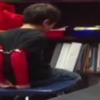There has been lot of buzz about a video shot last year of a Kentucky deputy sheriff handcuffing an 8-year-old schoolboy with attention deficit hyperactivity disorder (ADHD) . Last week, the American Civil Liberties Union filed a lawsuit against the deputy for this incident and a similar cuffing involving a 9-year-old girl.
The video is almost a caricature of how not to deal with children, and it should prompt parents to ask a simple and important question:
Even if the personnel at my child’s school wouldn’t think of calling the police if he acted out, would they know the right way to handle him?
There are a host of reasons why a child might misbehave. While this child’s acting out is attributed to his diagnosis of ADHD, a problem faced by about 10 percent of American children, all children risk exposure to traumatic events that can result in acting out. For example:
- One of five children may experience some type of sexual abuse before their 18th birthday, and in about a quarter of those cases, the abuse will be from another child or adolescent.
- More than 1.5 million children experience their parents’ divorce each year, meaning up to 20 million children experience parental divorce before they reach age 18.
- At any point in time, almost 3 million children under 18 have an incarcerated parent, meaning that as many as 10 million children suffer the incarceration of a parent before they reach age 18.
Each of these experiences is considered an Adverse Childhood Experience, or ACE, and long-term studies supported by the Centers for Disease Control and Prevention tell us that these experiences can have both immediate and lifelong effect on social and emotional health. And new research is expanding the list of ACEs, demonstrating that poverty, racism, and other experiences have the same negative effects on social, emotional, and physical health as the original eight ACEs identified more than a decade ago. ACEs can be a cause for dramatic changes in a child’s behavior, with boys being more likely to act out and girls being more likely to quietly internalize the pain, and thus staying under the radar.
Children who have not been alive long enough to experience ACEs still are at risk for environmental circumstances impacting their brain development and therefore potentially their behavior. For example, research shows that that inadequate nurturing and exposure to constant stress can cause structural changes in how a baby’s brain develops and how a child learns to react to her environment.
Enlightened educators and caregivers understand the relationship between the word discipline and disciple, embracing concepts like trauma informed practices and social-emotional learning to intervene with troubled young people. There are great resources to support this work and parents would be wise to determine if the schools and agencies serving their children have brought these resources home.
As a former public official, my standard always was that if a program or policy wasn’t good enough for my child, it wasn’t good enough for anyone’s child. As a citizen, I challenge parents to ensure that kids in their school district who act out due to disability or trauma are treated with evidenced-based strategies to help them recover and grow. As Frederick Douglas said almost two centuries ago “It is easier to build strong children than to repair broken men.” It’s also more humane.
This post originally appeared at:
http://www.philly.com/philly/blogs/healthy_kids/Kids-and-trauma-Science-trumps-handcuffs-.html
Dr. Janet Rosenzweig is the Vice President, Research and Programs for Prevent Child Abuse America and the author of The Sex-Wise Parent and The Parent’s Guide to Talking About Sex: A Complete Guide to Raising (Sexually) Safe, Smart, and Healthy Children. For more information, read her blog , follow @JanetRosenzweig on Twitter or contact DrRosenzweig@sexwiseparent.com to schedule a program for your school or community group.



Comments (1)